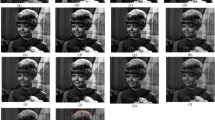Abstract
This paper presents two novel recursive partitioned one-to-one gray level mapping (RPOGM) algorithms, viz., recursive median partitioned one-to-one gray level mapping (RMDPOGM) and recursive mean partitioned one-to-one gray level mapping (RMPOGM). The proposed RPOGM methods serve multiple objectives and address the issues such as (i) intensity saturation, (ii) intensity compression and (iii) ensure uniform degree of enhancement of all gray levels and thus result in overall enhancement of the processed image. In RMPOGM, image/histogram is partitioned recursively, (recursion level restricted to two, resulting in four sub-histograms) based on mean. RMDPOGM is similar to RMPOGM except histogram partitioning is done based on median. In RPOGM methods, image-dependent weights for each sub-histogram are calculated separately. Later, these weights are used for transformation. Finally, all the transformed sub-images are combined to get the processed image. As the images processed by these methods are not having any loss of details, it results in retaining the structural details of the objects and hence preserves fine contours even after enhancement. This results in low gradient magnitude similarity deviation (GMSD) between the processed image and input image. Experimental results show the superiority of the proposed methods over the state-of-the-art histogram equalization methods in terms of preserving entropy, preserving mean brightness and having low GMSD.






Similar content being viewed by others
References
M. Abdullah-Al-Wadud, M.H. Kabir, M.A. Dewan, O. Chae, A dynamic histogram equalization for image contrast enhancement. IEEE Trans. Consum. Electron. 53(2), 593–600 (2007)
P.B. Aquino-Morínigo, F.R. Lugo-Solís, D.P. Pinto-Roa, H.L. Ayala, J.L. Noguera, Bi-histogram equalization using two plateau limits. SIViP 11(5), 857–864 (2017)
S.D. Chen, A.R. Ramli, Minimum mean brightness error bi-histogram equalization in contrast enhancement. IEEE Trans. Consum. Electron. 49(4), 1310–1319 (2003)
S.D. Chen, A.R. Ramli, Contrast enhancement using recursive mean-separate histogram equalization for scalable brightness preservation. IEEE Trans. Consum. Electron. 49(4), 1301–1309 (2003)
R.C. Gonzalez: Digital image processing: Pearson Education India. (2009)
M. Hanmandlu, O.P. Verma, N.K. Kumar, M. Kulkarni, A novel optimal fuzzy system for color image enhancement using bacterial foraging. IEEE Trans. Instrum. Meas. 58(8), 2867–2879 (2009)
H. Ibrahim, N.S. Kong, Brightness preserving dynamic histogram equalization for image contrast enhancement. IEEE Trans. Consum. Electron. 53(4), 1752–1758 (2007)
Y.T. Kim, Contrast enhancement using brightness preserving bi-histogram equalization. IEEE Trans. Consum. Electron. 43(1), 1–8 (1997)
M. Kim, M.G. Chung, Recursively separated and weighted histogram equalization for brightness preservation and contrast enhancement. IEEE Trans. Consum. Electron. 54(3), 1389–1397 (2008)
S.H. Lim, N.A.M. Isa, C.H. Ooi, K.K.V.A. Toh, New histogram equalization method for digital image enhancement and brightness preservation. SIViP 9(3), 675–689 (2015)
C.H. Ooi, N.A.M. Isa, Quadrants dynamic histogram equalization for contrast enhancement. IEEE Trans. Consum. Electron. 56(4), 2552–2559 (2010)
C.H. Ooi, N.S. Kong, H. Ibrahim, Bi-histogram equalization with a plateau limit for digital image enhancement. IEEE Trans. Consum. Electron. 55(4), 2072–2080 (2009)
E. Reddy, R. Reddy: Dynamic clipped histogram equalization technique for enhancing low contrast images. Proceedings of the National Academy of Sciences, India Section A: Physical Sciences, 1–26 (2018)
K. Santhi, R.S.D. Wahida-Banu, Adaptive contrast enhancement using modified histogram equalization. Optik Int. J. Light Electron. Opt. 126(19), 1809–1814 (2015)
K.S. Sim, C.P. Tso, Y.Y. Tan, Recursive sub-image histogram equalization applied to gray scale images. Pattern Recogn. Lett. 28(10), 1209–1221 (2007)
K. Singh, R. Kapoor, Image enhancement via median-mean based sub-image-clipped histogram equalization. Optik Int. J. Light Electron. Opt. 125(17), 4646–4651 (2014)
K. Singh, R. Kapoor, Image enhancement using exposure based sub image histogram equalization. Pattern Recogn. Lett. 36, 10–14 (2014)
K. Singh, R. Kapoor, S.K. Sinha, Enhancement of low exposure images via recursive histogram equalization algorithms. Optik Int. J. Light Electron. Opt. 126(20), 2619–2625 (2015)
J.R. Tang, N.A.M. Isa, Adaptive image enhancement based on bi-histogram equalization with a clipping limit. Comput. Electr. Eng. 40(8), 86–103 (2014)
Q. Wang, R.K. Ward, Fast image/video contrast enhancement based on weighted thresholded histogram equalization. IEEE Trans. Consum. Electron. 53(2), 757–764 (2007)
Y. Wang, Q. Chen, B. Zhang, Image enhancement based on equal area dualistic sub-image histogram equalization method. IEEE Trans. Consum. Electron. 45(1), 68–75 (1999)
W. Xue, L. Zhang, X. Mou, A.C. Bovik, Gradient magnitude similarity deviation: a highly efficient perceptual image quality index. IEEE Trans. Image Process. 23(2), 684–695 (2014)
Author information
Authors and Affiliations
Corresponding author
Rights and permissions
About this article
Cite this article
Reddy, M.E., Reddy, G.R. Recursive Median and Mean Partitioned One-to-One Gray Level Mapping Transformations for Image Enhancement. Circuits Syst Signal Process 38, 3227–3250 (2019). https://doi.org/10.1007/s00034-018-1013-3
Received:
Revised:
Accepted:
Published:
Issue Date:
DOI: https://doi.org/10.1007/s00034-018-1013-3




